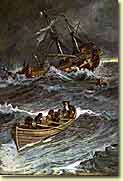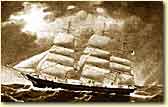

|


Suddenly a heavy blow struck the starboard quarter and careened
the ship over on her side...A crash was heard overhead--chains rattling and
falling, sails madly flapping, yardarms snapping and masts breaking; for a few
seconds, the noise was terrific..."
-forty-niner Linville Hall describes a storm at sea
from Gold Dust, by Donald Dale Jackson
 The Edward Everett sailed from Boston in 1849, bound for California
around Cape Horn, at the tip of South America. The gold seekers on board
enjoyed a variety of foods, including cheese and butter, potpies, plum pudding,
and applesauce. Scheduled activities included lectures and Sunday church
services. The Edward Everett sailed from Boston in 1849, bound for California
around Cape Horn, at the tip of South America. The gold seekers on board
enjoyed a variety of foods, including cheese and butter, potpies, plum pudding,
and applesauce. Scheduled activities included lectures and Sunday church
services.
Most forty-niners traveling the 15,000-mile journey around Cape Horn did not
enjoy such luxuries. They paid anywhere from $100 to $1000 and spent up to 8
months on board ship, packed together into tiny rooms or in the ship's hold.
 In good weather, the travelers could enjoy the beauty of the sea. And stops in
exotic ports such as Rio de Janiero in Brazil made life interesting. But as the
voyage went on, the boredom could become maddening. To pass the time, gold
seekers gambled and played checkers, told stories, and daydreamed of gold. In good weather, the travelers could enjoy the beauty of the sea. And stops in
exotic ports such as Rio de Janiero in Brazil made life interesting. But as the
voyage went on, the boredom could become maddening. To pass the time, gold
seekers gambled and played checkers, told stories, and daydreamed of gold.
Usually, there were two varieties of food--boring and awful. Meats and
vegetables spoiled quickly in the hot climate near the equator. Worms burrowed
through the bread. The water tasted foul. Some men got scurvy, a disease caused
by lack of foods containing vitamin C. Their gums bled and their teeth fell
out. A few even died. Diseases such as cholera killed men as well. Dead bodies
were wrapped in canvas cloth and buried at sea.
 The most dangerous leg of the journey was the sail around the very tip of Cape
Horn. Monstrous waves, terrifying winds, and frigid temperatures challenged
even the most experienced captains. Some took a short cut through the Strait of
Magellan. But that passage was narrow and sometimes deadly. The most dangerous leg of the journey was the sail around the very tip of Cape
Horn. Monstrous waves, terrifying winds, and frigid temperatures challenged
even the most experienced captains. Some took a short cut through the Strait of
Magellan. But that passage was narrow and sometimes deadly.
 Still, the Cape Horn route was probably the safest of all the routes to the
gold fields. Thousands of men made the trip successfully. But even after their
15,000 mile journey, forty-niners arrived in California with no guarantee of
success. Year later, many would return home, no richer than when they'd left
for California.
Still, the Cape Horn route was probably the safest of all the routes to the
gold fields. Thousands of men made the trip successfully. But even after their
15,000 mile journey, forty-niners arrived in California with no guarantee of
success. Year later, many would return home, no richer than when they'd left
for California.
Oregon-California Trail | Panama Shortcut
|

